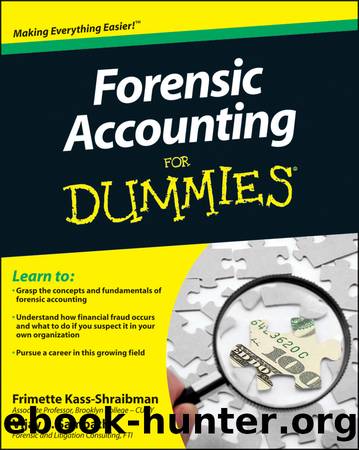Forensic Accounting For Dummies by Frimette Kass-Shraibman

Author:Frimette Kass-Shraibman
Language: eng
Format: epub
Publisher: Wiley
Published: 2011-01-04T00:00:00+00:00
Chapter 13
Tracing the Flow of Money
In this Chapter
Studying a companyâs financials
Getting intimate with bank records, 1099s, and credit card statements
Interviewing key witnesses
Looking at your targetâs lifestyle
Within a business, cash can be manipulated in two ways: It can either be misappropriated or âcreatedâ in a companyâs financial statements. The first type of fraud occurs when employees or managers steal cash from a company. Small businesses are more susceptible to defalcation (misappropriation) of cash because they have fewer internal controls in place to detect the fraud. In large businesses, management can override the controls to perpetrate fraud.
The second type of fraud is rare and extremely difficult to carry out. The assumption here is that the cash and bank balances reported in the companyâs financial statements are fake. To carry this out, someone has to artificially inflate the revenues first.
This type of financial statement fraud occurred in one of the largest corporate frauds in history involving Parmalat, a multinational Italian dairy and food company. Parmalatâs management fabricated invoices to inflate revenues and then âcreatedâ cash to make the inflated revenues seem genuine. Management also forged a bank confirmation showing a balance of $4.9 billion. This type of fraud is difficult to pull off without getting caught because cash is cash, and itâs virtually impossible to âcreateâ cash without raising some obvious red flags.
As a result of this fraud, Parmalat was forced to declare bankruptcy at the end of 2003. It was estimated that a billion Euros were missing. Thatâs a lot of cheese!!
When investigating occupational fraud (and other types as well), following the money trail is essential. In this chapter, we discuss the methods you use to trace the money so you not only detect fraud, but also build a case to bring the perpetrators to justice.
Identifying Potential Red Flags
There are many red flags for missing money, and many of them dovetail with the general signs and symptoms of fraud. We focus here on occupational fraud (the subject of Part II of this book) and review some of the signs of missing cash that can be found on a companyâs financial statements.
Analyzing financial statement basics
As we discuss in Chapter 5, financial statements are a picture of a companyâs financial condition and a record of business for a certain period of time. One quick way to determine if cash is a problem (for example, itâs disappearing) is to compare the companyâs revenues, accounts receivable, and cash flows.
In a properly functioning business, accounts receivable should grow with sales, and revenues and cash flows should be closely correlated. If sales are staying the same, and accounts receivable are up, you have to ask why. Itâs possible that there are collection problems or that someone is stealing cash. If sales are up, accounts receivable down, and cash flows steady, you might ask, âWhereâs the money?â In short: If business is up, the company should have more money. If the financial statements donât show more money, ask why. Maybe the business
Download
This site does not store any files on its server. We only index and link to content provided by other sites. Please contact the content providers to delete copyright contents if any and email us, we'll remove relevant links or contents immediately.
Zero to IPO: Over $1 Trillion of Actionable Advice from the World's Most Successful Entrepreneurs by Frederic Kerrest(3940)
Harry Potter and the Goblet Of Fire by J.K. Rowling(3581)
Never by Ken Follett(3489)
Machine Learning at Scale with H2O by Gregory Keys | David Whiting(3443)
Ogilvy on Advertising by David Ogilvy(3289)
Shadow of Night by Deborah Harkness(3154)
The Man Who Died Twice by Richard Osman(2777)
Book of Life by Deborah Harkness(2696)
My Brilliant Friend by Elena Ferrante(2675)
How Proust Can Change Your Life by Alain De Botton(2588)
0041152001443424520 .pdf by Unknown(2569)
Will by Will Smith(2547)
The Tipping Point by Malcolm Gladwell(2528)
How to Pay Zero Taxes, 2018 by Jeff A. Schnepper(2456)
Purple Hibiscus by Chimamanda Ngozi Adichie(2419)
Hooked: A Dark, Contemporary Romance (Never After Series) by Emily McIntire(2397)
Rationality by Steven Pinker(2124)
Borders by unknow(2091)
Daughter of Smoke and Bone by Laini Taylor(2056)
